What is Negitoro Don?
Negitoro (ネギトロ丼) is a unique Japanese preparation method using raw tuna. Originally, it was made by vendors who bought whole tuna, shaving off the meat in the crevices between the bones and behind the skin after the tuna was filleted so that there was no waste and every last bit was consumed.
Donburi is basically a dish in which rice is served in a bowl and topped with ingredients. So negitoro don can be translated as mashed sashimi tuna bowl.
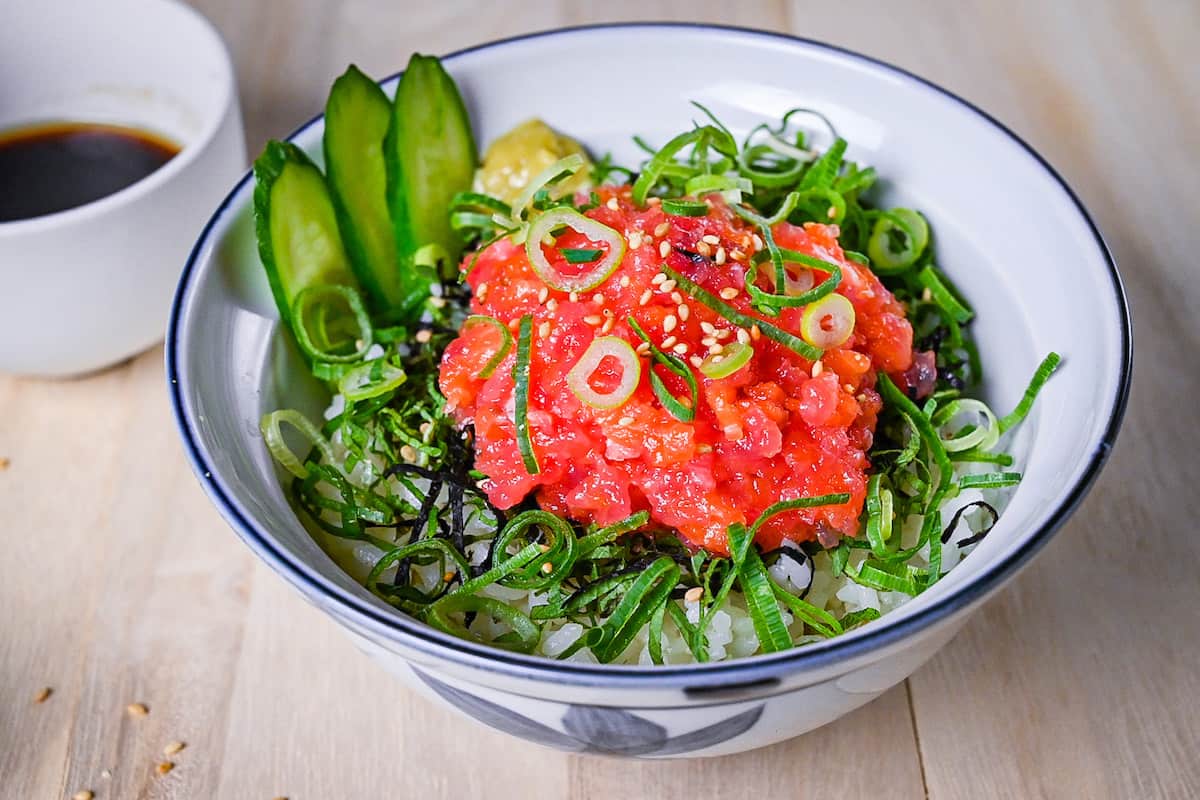
Ingredients & Substitution Ideas
- Sashimi-Grade Tuna – Use only sashimi (sushi) grade tuna that is safe for raw consumption. The most budget-friendly tuna cut works great.
- Sashimi-Grade Salmon – Likewise, select sashimi-grade salmon. Substitute smoked salmon if needed.
- Sauce – Blend sake, mirin, soy sauce, sugar, and a dash of sesame oil (and optional dashi stock) to taste.
- Toppings – Consider perilla leaves, shredded nori, wasabi (optional), chopped green onions, cucumber, and toasted sesame seeds.
- Cooked Japanese Short-Grain Rice – For the right tender yet chewy texture, use Japanese short-grain rice. Check out my guide on how to cook perfect Japanese rice, along with recommended rice brands easily found in the U.S.
Feel free to customize the dish to your liking Here are a few suggestions:
- Add vegetables such as avocado, okra, or grated daikon for a more nutritious bowl.
- Drizzle with chili oil for a spicy kick.
- Top with an egg yolk (from a pasteurized egg) for a richer taste.
- Use negitoro to make sushi rolls instead of donburi
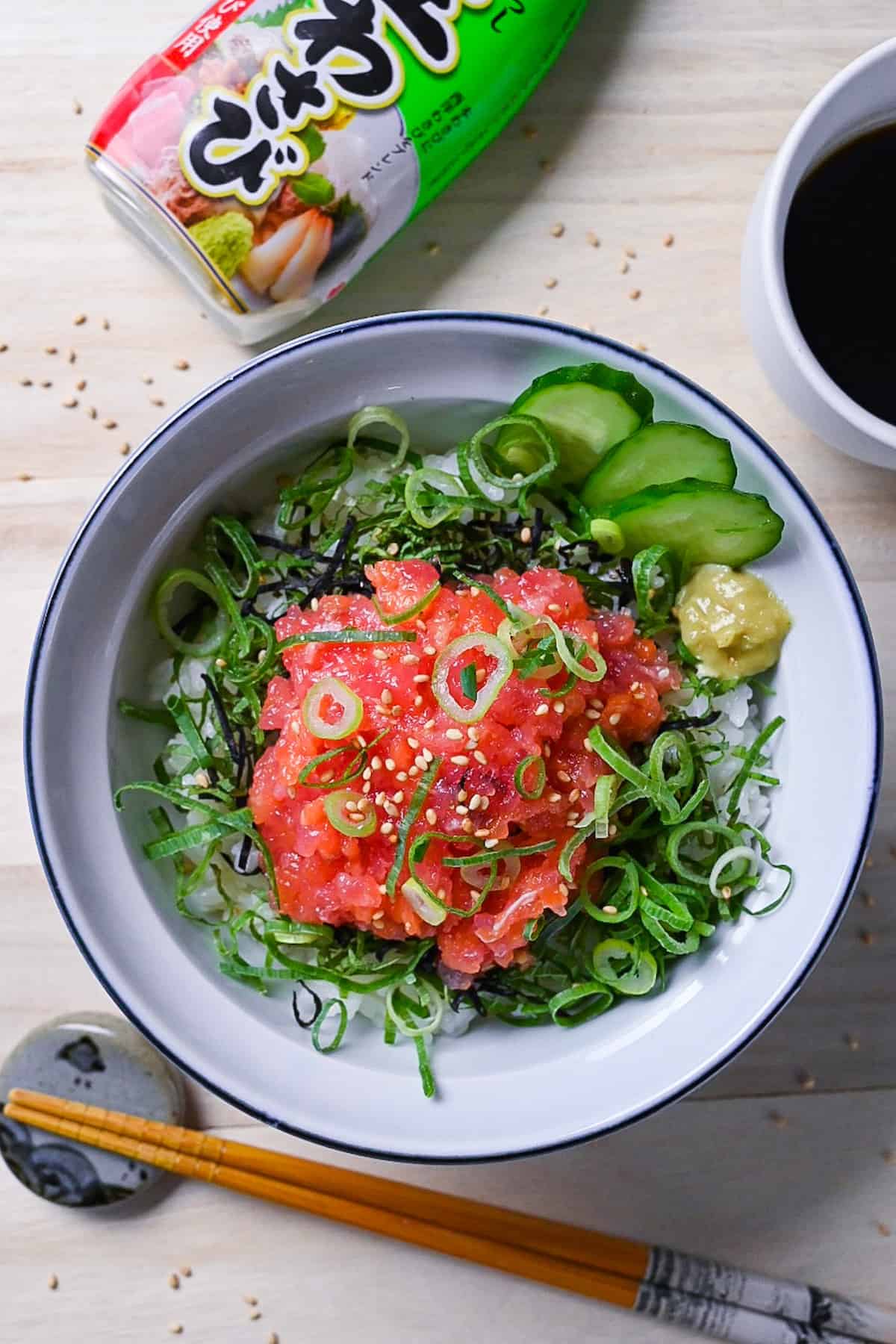
Visual Walkthrough & Tips
Here are my step-by-step instructions for how to make Negitoro Don at home. For ingredient quantities and simplified instructions, scroll down for the Printable Recipe Card below.
I recommend making it first because the sauce needs a little time to cool. It’s super easy and can be made in 3 simple steps!
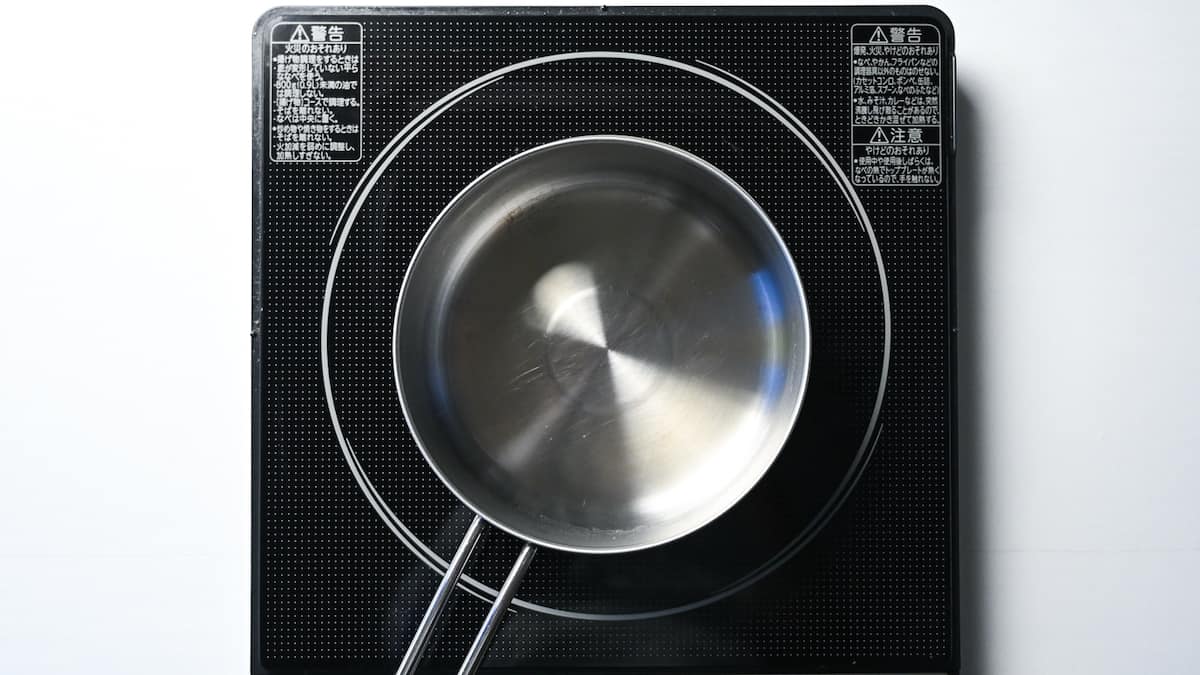
1. First, heat the sake and mirin in a small saucepan and bring it to a boil. Let it boil for 30 seconds. This is to burn off the alcohol in the sake and mirin.
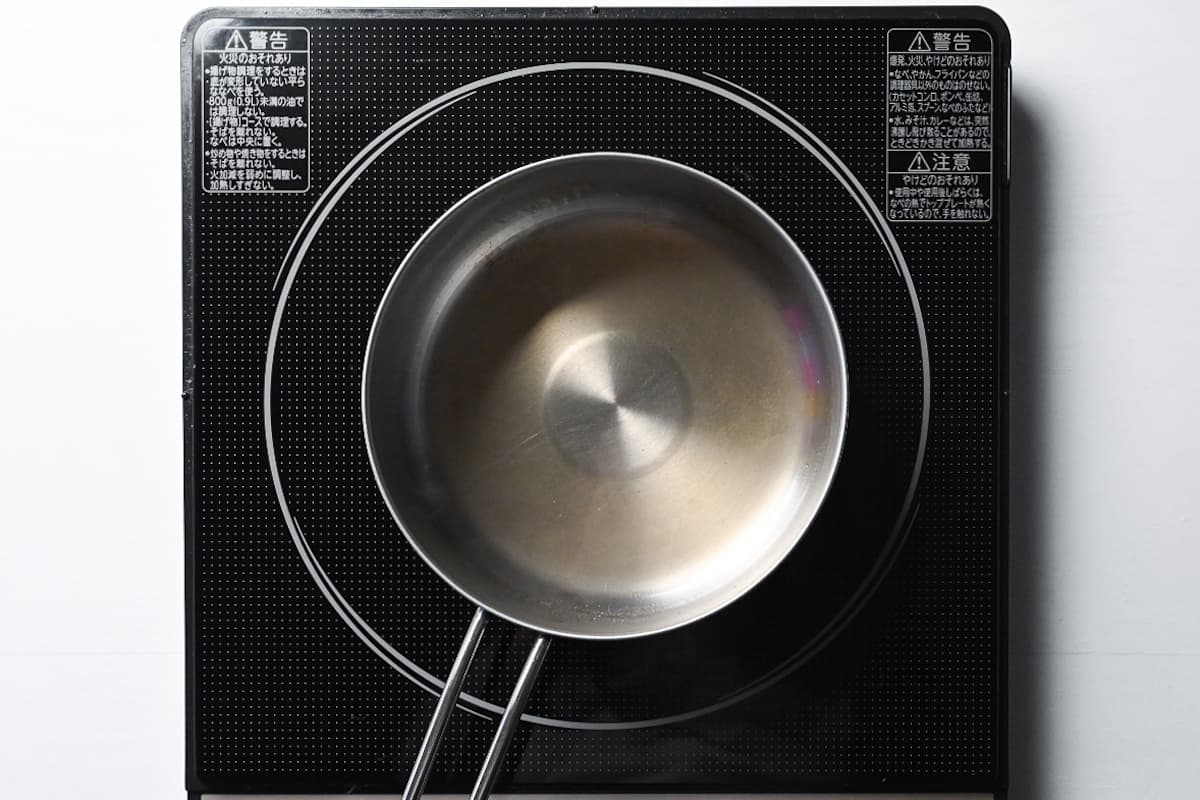
After burning off the alcohol, turn the heat down to a simmer and add sugar and dashi to the pan. Mix over the low heat until the sugar is dissolved.
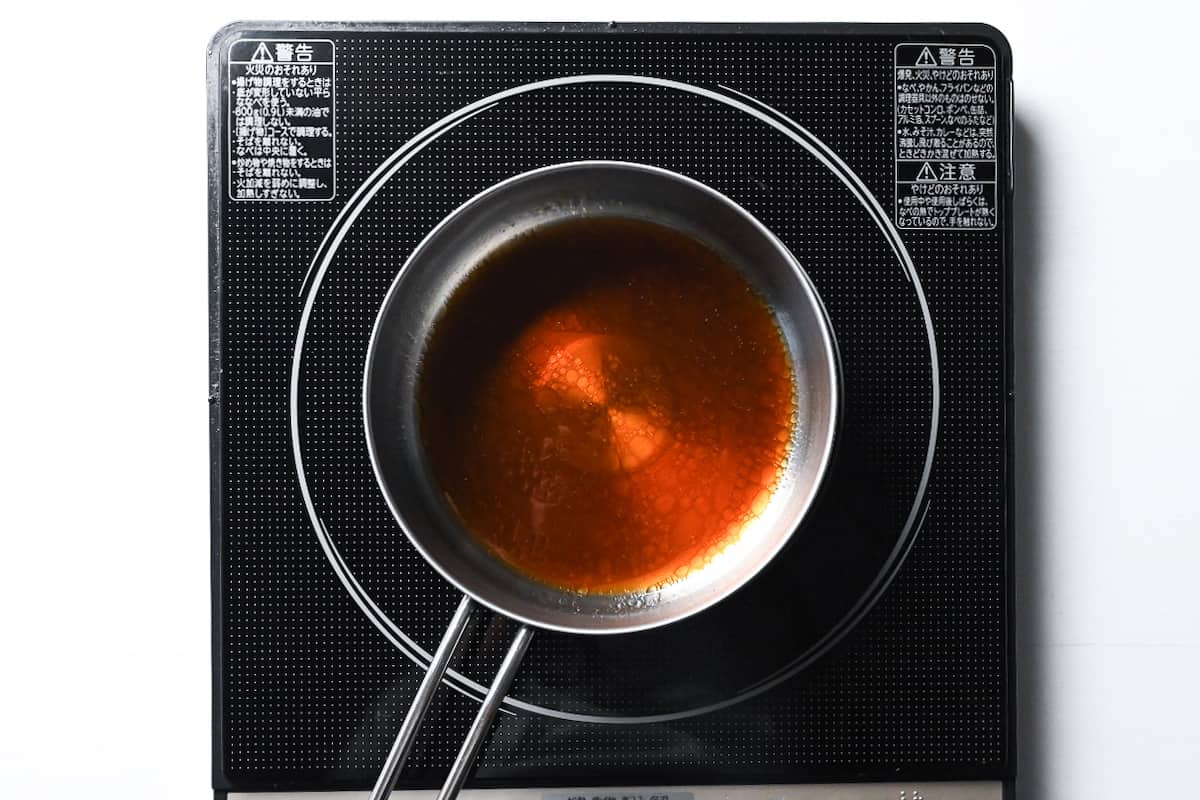
Finally, turn off the heat and add the soy sauce and sesame oil.
Remove from the heat and leave to cool for about 10 minutes. That’s all there is to it!
Negitoro is essentially mashed up tuna, all you need for this step is a chopping board and a sharp knife.
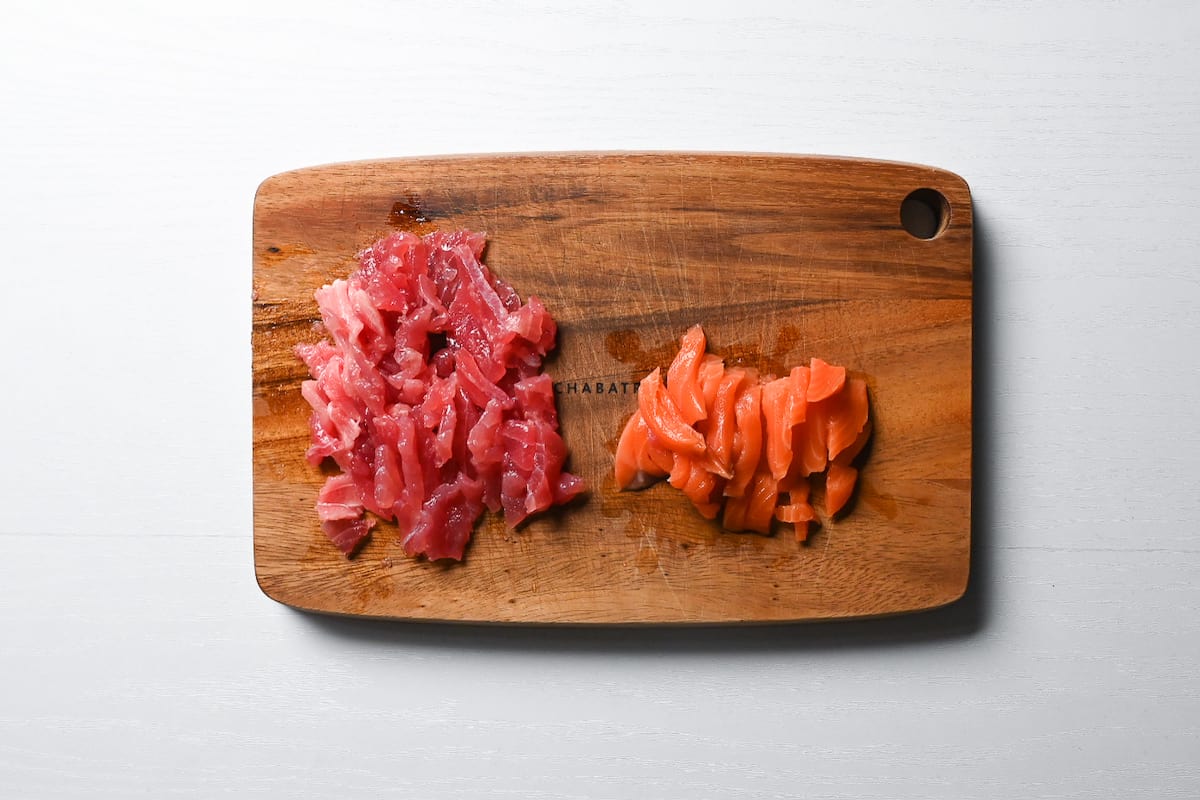
Start by cutting your tuna and salmon into small strips. This just makes it easier to “mash” in the next step.
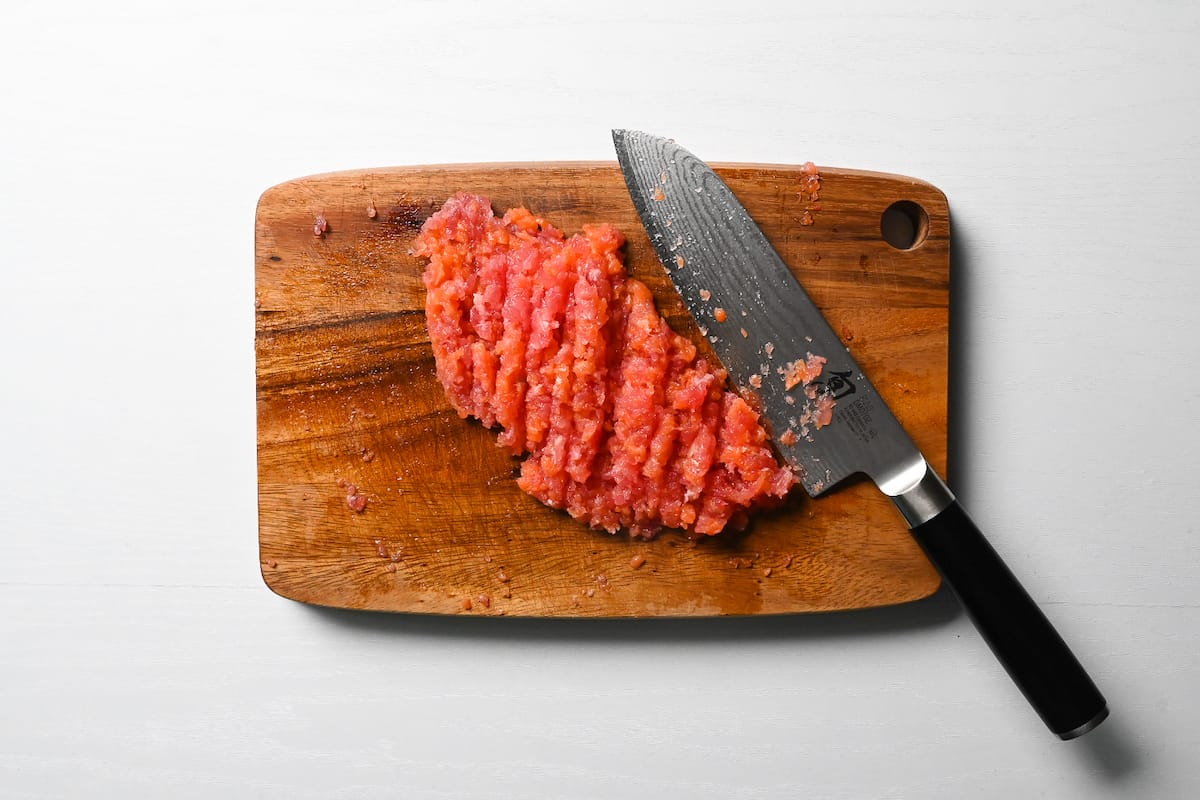
Finely dice the tuna and salmon by cutting in all directions using a rocking motion with your knife. As the fish spreads out, scoop it back together and continue to dice until it is relatively fine and no large chunks are left.
All that’s left is assembling!
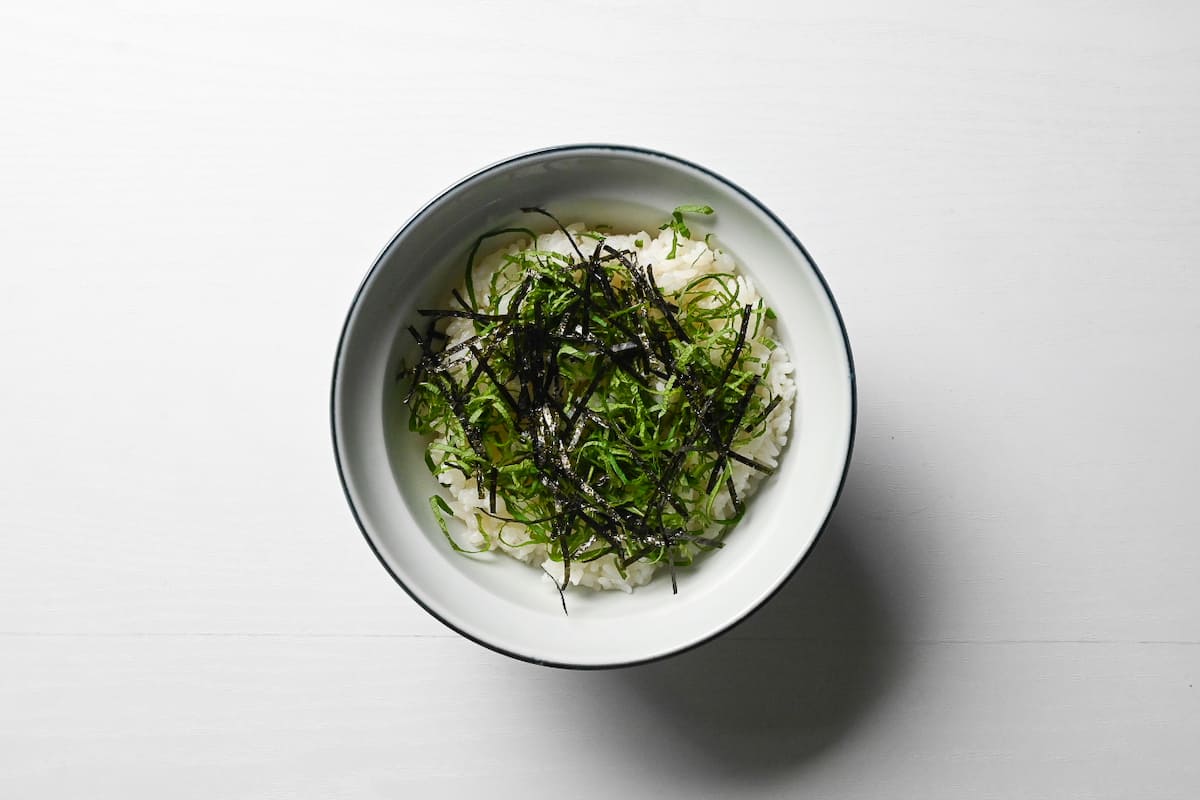
Dish up the rice and top with a bed of finely sliced spring onion and nori. (Save some spring onion for sprinkling at the end too.)
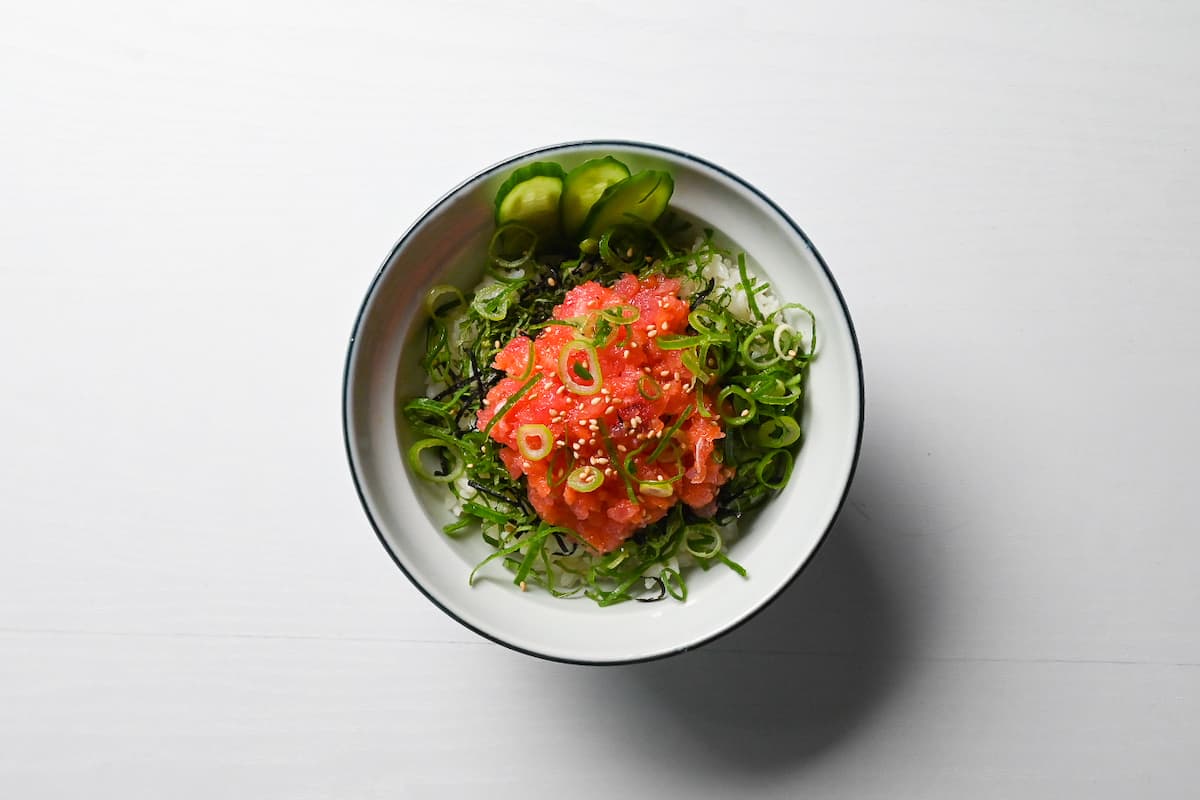
Place your handmade negitoro on top and sprinkle with more chopped spring onion and a few toasted white sesame seeds. I also serve negitoro don with a generous blob of wasabi and a few slices of cucumber for a refreshing crunch!
Finally, drizzle the sauce over the top, mix well, and enjoy!
Jump to Full Recipe MeasurementsFAQ
As you might already know, “Negi” in Japanese means spring onion, and “toro” is an expensive, fatty part of tuna. So you might think negitoro must have something to do with these. However, the origin of negitoro has nothing to do with these.
Negi is derived from the word “negitoru” which means to “scrape off”. The word “negi” actually has nothing to do with the vegetable itself, and while it is true that negitoro is often served with chopped spring onion over it, the “negitoro” (minced tuna) part itself does not contain spring onion.
The same goes with the “toro” part. Negitoro is not necessarily made from the expensive part of tuna. There are various theories as to why the word “toro” was added, but the most popular theory is that it is because it has a soft texture like toro.
The most commonly used part of tuna for negitoro is nakaochi (中落ち), which is the extra flesh attached to the head, mid-bone, fins, and tail.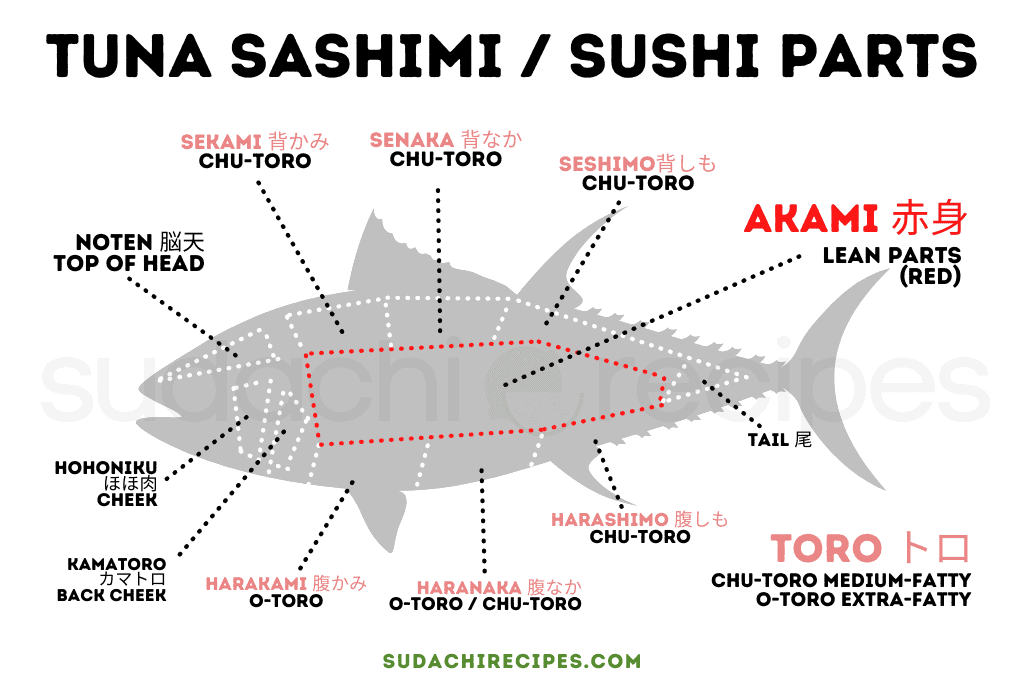
While negitoro is heavily associated with tuna, some supermarkets or chain sushi restaurants use opah instead. The flesh of opah is very similar to that of tuna and cheaper.
In fact, it is similar to tuna in taste and texture and is actually very tasty. Personally, I consider opah to be far superior compared to making negitoro with “akami” red meat (lean part) of tuna.
If you buy negitoro premade in the supermarket, it is usually made by mixing the cheaper red meat with either fat from the tuna or sometimes with opah (which is fattier than tuna), albacore, or yellow tail to keep costs down. This is also why the dish is simply known as “negitoro”, rather than “tuna negitoro”, it might not be 100% tuna!
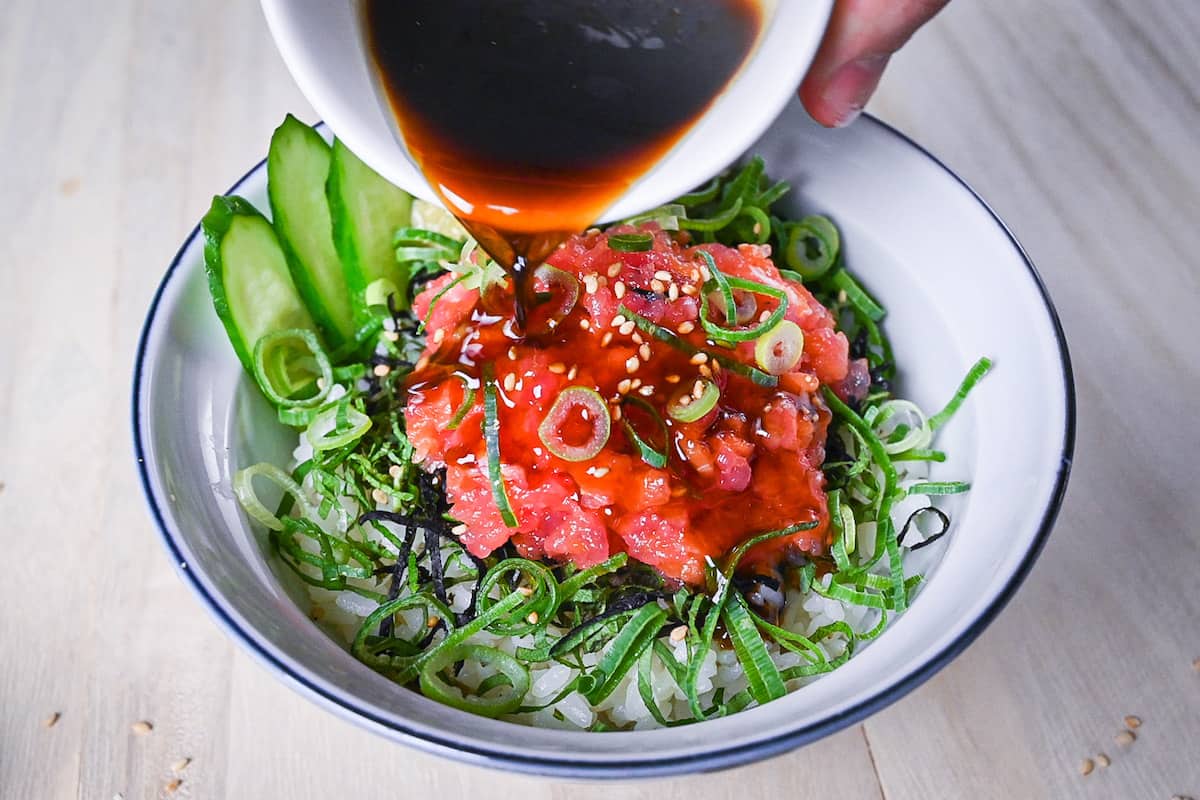
I hope you enjoy this Negitoro Don recipe! If you try it out, I’d really appreciate it if you could spare a moment to let me know what you thought by giving a review and star rating in the comments below. It’s also helpful to share any adjustments you made to the recipe with our other readers. Thank you!
More Donburi Recipes
- Tekka Don (Japanese Tuna Sashimi Rice Bowl)
- Kaisen Donburi (Seafood Rice Bowl)
- Maguro Zuke Don (Marinated Tuna Sashimi Bowl)
- Unagi Donburi (Japanese Grilled Eel Rice Bowl)
Want more inspiration? Explore my Donburi Recipe Roundup Post for a carefully selected collection of tasty udon recipe ideas to spark your next meal!
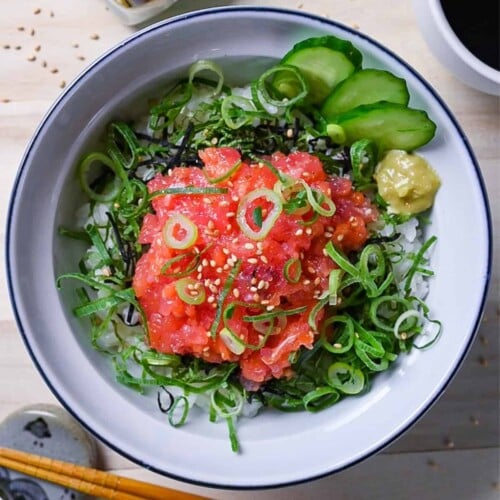
Negitoro Don (Mashed Tuna Sashimi Bowl)
Equipment
- Zojirushi Rice Cooker (optional)
Ingredients
Sauce
- 2 tbsp sake
- 1 tbsp mirin
- 1 tbsp Japanese soy sauce (koikuchi shoyu)
- 1 tsp sugar
- ½ tbsp dashi stock liquid, not powder (alternatively, sub with water and a small pinch of dashi granules)
- 1 tsp toasted sesame oil
Negitoro don
- 3 perilla leaves (shiso) thinly sliced
- 2 tbsp kizami nori (shredded nori)
- wasabi paste to taste
- 2 tbsp green onion finely chopped
- 30 g Japanese cucumber diagonally sliced
- 150 g sashimi-grade tuna
- 50 g sashimi-grade salmon
- 2 portions cooked Japanese short-grain rice
- 1 tsp toasted white sesame seeds
My recommended brands of ingredients and seasonings can be found in my Japanese pantry guide.
Can’t find certain Japanese ingredients? See my substitution guide here.
Instructions
- Add 2 tbsp sake and 1 tbsp mirin to a small sauce pan and heat on medium. Bring to boil and allow to bubble for 30 seconds.

- Turn heat down to low and add 1 tsp sugar and ½ tbsp dashi stock. Mix over the heat until sugar is dissolved.

- Once the sugar is dissolved, turn off the heat and add 1 tbsp Japanese soy sauce (koikuchi shoyu) and 1 tsp toasted sesame oil. Mix and remove from the stove. Leave to cool for about 10 minutes.

- Using sharp knife, cut 150 g sashimi-grade tuna and 50 g sashimi-grade salmon into thin strips.

- Finely dice the tuna and salmon using a rocking motion with your knife. As the tuna and salmon spreads out, scrape it back to the centre and repeat, cutting in different directions each time until a “mince” is formed.

- Divide 2 portions cooked Japanese short-grain rice into portions and make a bed of 3 perilla leaves (shiso) and 2 tbsp kizami nori (shredded nori).

- Place the mashed tuna and salmon on top and sprinkle with 2 tbsp green onion and 1 tsp toasted white sesame seeds. Arrange 30 g Japanese cucumber on the side with wasabi paste to taste and pour the sauce over the top.

- Mix well before eating and enjoy!
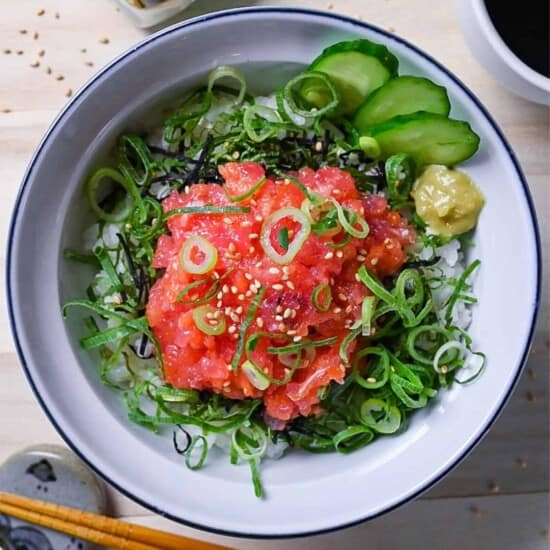


Leave a rating and a comment